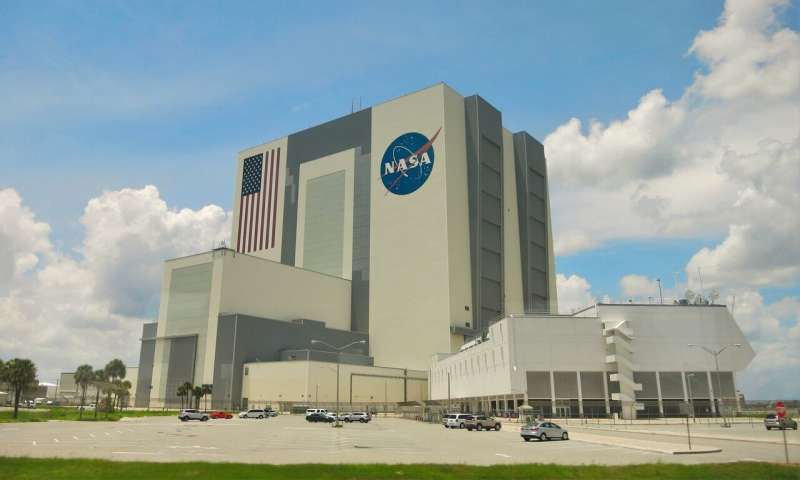This article has been reviewed according to Science X's editorial process and policies. Editors have highlighted the following attributes while ensuring the content's credibility:
fact-checked
reputable news agency
proofread
NASA's massive moon booster arrives at Kennedy Space Center

It's still covered up in what looks like the world's largest PEZ dispenser, but the core stage booster for NASA's Space Launch System rocket for the Artemis II moon mission arrived by barge to Florida on Tuesday.
The 212-foot-long tank still sits hidden within NASA's Pegasus barge with its ridged, football-field-length silver dome protecting the Boeing-built hardware that cost more than $1 billion to manufacture. The barge is docked at KSC's Turn Basin after completing the 900-mile trip from NASA's Michoud Assembly Facility in New Orleans. Plans are to haul the stage over to the neighboring Vehicle Assembly Building on Wednesday.
It still has months of checkouts ahead while lying on its side before it will go vertical to be stacked alongside the two solid rocket boosters from Northrop Grumman that remain stored in segments at the nearby Rotation, Processing and Surge Facility. Stacking won't begin until at least September, said Artemis II Mission Manager Matthew Ramsey.
"It takes six to eight weeks to fully stack the booster segments, and the core stage will go after that," he said.
Together, they will produce 8.8 million pounds of thrust to launch the Lockheed Martin-built Orion spacecraft set to send NASA astronauts Reid Wiseman, Victor Glover and Christina Koch along with Canadian astronaut Jeremy Hansen on what would be the first return of humans to the moon since the Apollo 17 mission in 1972.
Launch is slated for no earlier than September 2025, with plans to send the quartet on a short trip around the moon and back to test out the life support systems for Orion. Artemis II would then set up the more complex Artemis III mission that looks to send the first humans, including the first woman, back to the surface of the moon since the end of the Apollo program.
The Orion capsule is also at KSC, but more work needs to be done on its heat shield before NASA will let humans fly on it. The Orion capsule that flew on Artemis I in 2022 landed in one piece, but its heat shield suffered more damage than expected.
The SLS rocket, though, performed extremely well on that inaugural launch, and with the core stage's arrival, nearly all the pieces are in hand to build it back up for the next one.
While the timeline from the start of stacking to launch is around one year, the time is actually a tight run, Ramsey said.
"We have some padding built into our schedule," he said. "At this point, it's not a huge amount, so we preciously guard that margin on a shift-by-shift and day-by-day basis."
2024 Orlando Sentinel. Distributed by Tribune Content Agency, LLC.





















